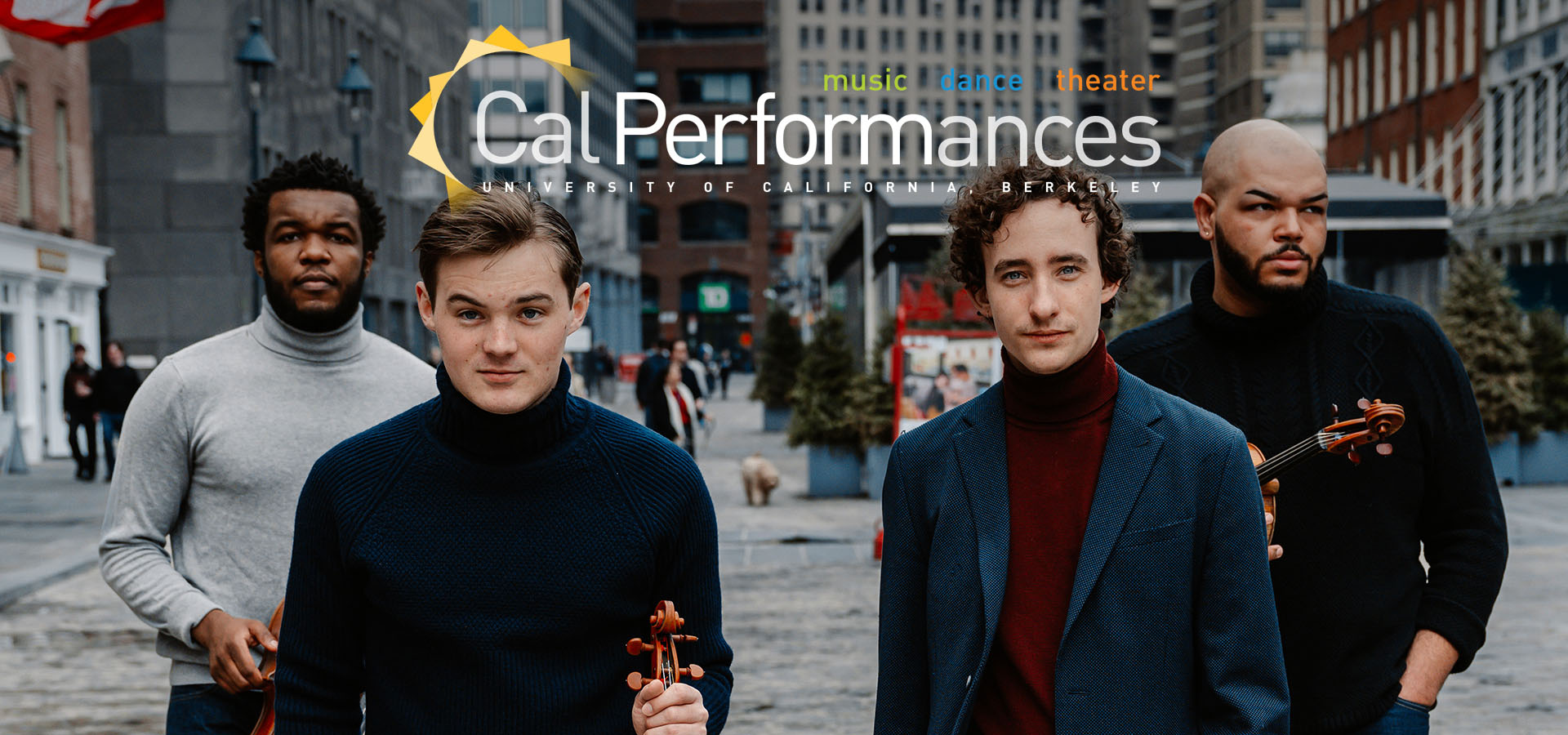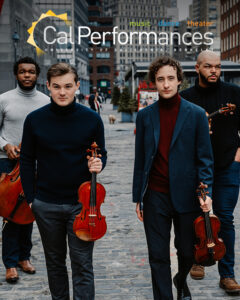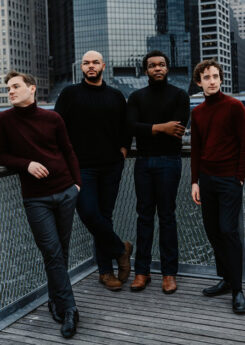Isidore String Quartet
Tuesday, March 5, 2024, 7:30pm
First Church (Formerly First Congregational Church), Berkeley
Adrian Steele, violin (first on Haydn & Beethoven)
Phoenix Avalon, violin (first on Childs)
Devin Moore, viola
Joshua McClendon, cello
Cal Performances is committed to fostering a welcoming, inclusive, and safe environment for all—one that honors our venues as places of respite, openness, and respect. Please see the Community Agreements section on our Policies page for more information.
The Isidore String Quartet appears by arrangement with David Rowe Artists. www.davidroweartists.com
From the Executive and Artistic Director
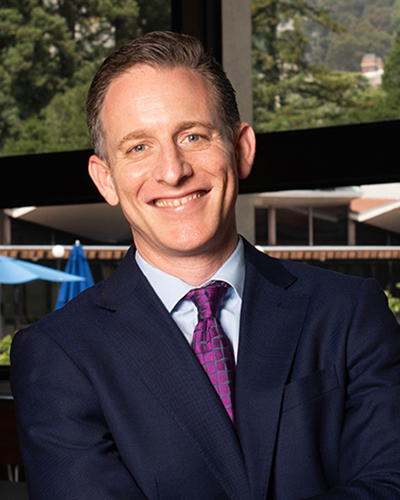
We continue our extraordinary 2023–24 season with a schedule of performances that would be the envy of any performing arts presenter in the nation. I’m especially proud that the legendary pianist Mitsuko Uchida will return to campus this month as Artist in Residence, for two special concerts—March 17 with tenor Mark Padmore in Schubert’s song cycle Winterreise, and March 24 with the acclaimed Mahler Chamber Orchestra in piano concertos by Mozart and an orchestral work by Jörg Widmann—as well as additional opportunities for the campus and wider Bay Area community to engage with her singular artistry. We are also very excited to welcome the return of one of the crown jewels in American dance, The Joffrey Ballet, which this year celebrates the renewal of a multi-season residency at Cal Performances with its first full-length narrative ballet, Anna Karenina, at Zellerbach Hall (Mar 15–17).
The iconic Elevator Repair Service theater company visits from New York with Baldwin and Buckley at Cambridge (Mar 1–3), its lean and elegant production about a historic 1965 debate between the progressive queer Black writer and activist James Baldwin and the “Father of American Conservatism,” William F. Buckley, Jr. And, the Bay Area’s beloved Kronos Quartet celebrates its 50th year of reinventing the string quartet for our global, connected, contemporary world with a special concert featuring a world premiere commissioned from Indonesian composer Peni Candra Rini, who will join the Kronos members onstage as a performer (Mar 2).
We’ll enjoy an artfully curated program by the brilliant young pianist Conrad Tao (Mar 3); the Cal Performances debut of a particularly exciting young string ensemble, the Isidore String Quartet (Mar 5); and the West Coast premiere of Ki moun ou ye (Who are you?), an immersive staged song cycle by composer, flutist, and vocalist Nathalie Joachim (Mar 7). Joachim’s piece is set on the remote Caribbean farmland where her family has lived for generations, and travels deeper into the Haitian heritage introduced on her Grammy-nominated Fanm d’Ayiti recording.
In other genres, the June Award-winning group OKAN demonstrates what can happen when you take a classically trained percussionist from Santiago de Cuba, add a one-time concertmaster from Havana’s Youth Orchestra, and stir in the sounds of Caribbean folkloric and dance music in the context of Toronto’s vibrant immigrant music community (Mar 8); and Wild Up, the dazzling Los Angeles contemporary music collective, reminds us how new a 50-year-old music score can sound with its presentation of Julius Eastman’s ecstatic, jubilant, and hypnotic Femenine. And finally, we can’t wait for the Cal Performances debut of Ema Nikolovska, a young mezzo-soprano on the rise and in demand in international opera houses and concert halls; born in North Macedonia, raised in Toronto, and based in Europe, Nikolovska visits with a program featuring songs by Schubert, Richard Strauss, and Debussy.
Even as all these remarkable performances take place on the UC Berkeley campus, the Cal Performances team is hard at work planning for the mid-April announcement of our 2024–25 season. Trust me when I promise that we have a truly exceptional schedule planned for you, an example of which was last month’s sneak-peak announcement of the Maria Manetti Shrem and Elizabeth Segerstrom California Orchestra Residency, when Cal Performances and the Philharmonic Society of Orange County will bring the world renowned Vienna Philharmonic, conductor Yannick Nézet-Séguin, and pianist Yefim Bronfman to California in March 2025.
Finally, thank you for joining us today at Cal Performances! We’re delighted to spend this time together, celebrating the very best in live music, dance, and theater.
Jeremy Geffen
Executive and Artistic Director, Cal Performances
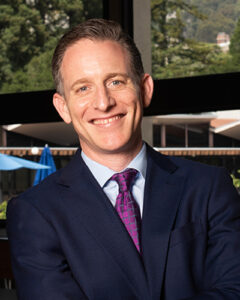 We continue our extraordinary 2023–24 season with a schedule of performances that would be the envy of any performing arts presenter in the nation. I’m especially proud that the legendary pianist Mitsuko Uchida will return to campus this month as Artist in Residence, for two special concerts—March 17 with tenor Mark Padmore in Schubert’s song cycle Winterreise, and March 24 with the acclaimed Mahler Chamber Orchestra in piano concertos by Mozart and an orchestral work by Jörg Widmann—as well as additional opportunities for the campus and wider Bay Area community to engage with her singular artistry. We are also very excited to welcome the return of one of the crown jewels in American dance, The Joffrey Ballet, which this year celebrates the renewal of a multi-season residency at Cal Performances with its first full-length narrative ballet, Anna Karenina, at Zellerbach Hall (Mar 15–17).
We continue our extraordinary 2023–24 season with a schedule of performances that would be the envy of any performing arts presenter in the nation. I’m especially proud that the legendary pianist Mitsuko Uchida will return to campus this month as Artist in Residence, for two special concerts—March 17 with tenor Mark Padmore in Schubert’s song cycle Winterreise, and March 24 with the acclaimed Mahler Chamber Orchestra in piano concertos by Mozart and an orchestral work by Jörg Widmann—as well as additional opportunities for the campus and wider Bay Area community to engage with her singular artistry. We are also very excited to welcome the return of one of the crown jewels in American dance, The Joffrey Ballet, which this year celebrates the renewal of a multi-season residency at Cal Performances with its first full-length narrative ballet, Anna Karenina, at Zellerbach Hall (Mar 15–17).
The iconic Elevator Repair Service theater company visits from New York with Baldwin and Buckley at Cambridge (Mar 1–3), its lean and elegant production about a historic 1965 debate between the progressive queer Black writer and activist James Baldwin and the “Father of American Conservatism,” William F. Buckley, Jr. And, the Bay Area’s beloved Kronos Quartet celebrates its 50th year of reinventing the string quartet for our global, connected, contemporary world with a special concert featuring a world premiere commissioned from Indonesian composer Peni Candra Rini, who will join the Kronos members onstage as a performer (Mar 2).
We’ll enjoy an artfully curated program by the brilliant young pianist Conrad Tao (Mar 3); the Cal Performances debut of a particularly exciting young string ensemble, the Isidore String Quartet (Mar 5); and the West Coast premiere of Ki moun ou ye (Who are you?), an immersive staged song cycle by composer, flutist, and vocalist Nathalie Joachim (Mar 7). Joachim’s piece is set on the remote Caribbean farmland where her family has lived for generations, and travels deeper into the Haitian heritage introduced on her Grammy-nominated Fanm d’Ayiti recording.
In other genres, the June Award-winning group OKAN demonstrates what can happen when you take a classically trained percussionist from Santiago de Cuba, add a one-time concertmaster from Havana’s Youth Orchestra, and stir in the sounds of Caribbean folkloric and dance music in the context of Toronto’s vibrant immigrant music community (Mar 8); and Wild Up, the dazzling Los Angeles contemporary music collective, reminds us how new a 50-year-old music score can sound with its presentation of Julius Eastman’s ecstatic, jubilant, and hypnotic Femenine. And finally, we can’t wait for the Cal Performances debut of Ema Nikolovska, a young mezzo-soprano on the rise and in demand in international opera houses and concert halls; born in North Macedonia, raised in Toronto, and based in Europe, Nikolovska visits with a program featuring songs by Schubert, Richard Strauss, and Debussy.
Even as all these remarkable performances take place on the UC Berkeley campus, the Cal Performances team is hard at work planning for the mid-April announcement of our 2024–25 season. Trust me when I promise that we have a truly exceptional schedule planned for you, an example of which was last month’s sneak-peak announcement of the Maria Manetti Shrem and Elizabeth Segerstrom California Orchestra Residency, when Cal Performances and the Philharmonic Society of Orange County will bring the world renowned Vienna Philharmonic, conductor Yannick Nézet-Séguin, and pianist Yefim Bronfman to California in March 2025.
Finally, thank you for joining us today at Cal Performances! We’re delighted to spend this time together, celebrating the very best in live music, dance, and theater.
Jeremy Geffen
Executive and Artistic Director, Cal Performances
About the Program
Joseph Haydn
String Quartet in C major, Op. 20, No. 2
Haydn’s Op. 20 quartets are pillars of the string quartet repertoire, works that both solidified the genre as worthy of its own lineage and introduced new compositional techniques into the post-Baroque classical world. They were composed in 1772, when the 40-year old Haydn was already well established as a composer, leading a busy life composing symphonic, chamber, and vocal works for the court of Prince Nikolaus Esterhazy.
In the second of the Op. 20 string quartets, Haydn begins immediately to challenge the existing hierarchy of voices, announcing the theme with a three-voice texture led by the cello. The traditional melodic instrument, the first violin, is made to wait its turn to state the theme once more before the exposition can continue. In the aftermath of such treason, Haydn, never lacking wit, seems almost to tease the first violinist with the cello’s sixteenth-note flourishes shortly thereafter, to which the first violin immediately responds with a dramatic run of its own.
Beyond the warm embrace of his melodies and the ease of his musical dialogue, Haydn also veers into darker territory in the quartet, introducing the concept of Sturm und Drang, clearly influenced by the burgeoning Romanticism of his contemporaries and the more operatic modes that he was writing in for his other duties in the Esterhazy court. The second movement introduces itself in a desperately grand, almost garishly ornamented statement from the whole ensemble, before a series of outbursts and laments, as if part of an operatic recitative. Haydn pairs this with an ever-developing chromaticism, incredibly apparent in the waning moments of the second movement and in the opening of the third.
In the third movement, Haydn adds to the minuet an ever-present drone, creating a bagpipe-like texture and allowing him to cleverly and chromatically introduce the subject of the fourth movement fugue against the G drone. In the finale, Haydn once again sets up the drama, marking the quartet sotto voce until the dam can no longer hold, leading to a dramatic and unexpected flurry of forte sixteenth notes that leads us to the end of the piece.
—Adrian Steele
Billy Childs (b. 1957)
String Quartet No. 2, Awakening
Los Angeles-native Billy Childs began performing publicly on the piano at the age of six and would eventually receive a bachelor’s degree in composition from the University of Southern California Community College of the Performance Arts. As a performer and composer, Childs was in demand early on, collaborating with pillars of the jazz industry, signing with Windham Hill Records in 1988, and receiving commissions from prestigious soloists and ensembles (Los Angeles Philharmonic, Detroit Symphony Orchestra, Kronos Quartet, Ying Quartet). A formative education, extensive experience, and an unwavering self-conception allowed the five-time Grammy Award-winning musician to develop a unique voice as a pianist and composer in both the classical and jazz worlds.
Commissioned by the Ying Quartet and completed in 2012, Childs’ String Quartet No. 2, Awakening depicts the emotional, physical, and spiritual journey in dealing with the serious illness of a loved one; it is inspired by Childs’ real life experience with his wife. After she was diagnosed with a pulmonary embolism and taken into emergency care, Childs, one state away, was notified of the situation and immediately rushed to be with her. This three-movement work outlines the complex emotional journey, providing insight into the vulnerability of the composer.
The first movement, titled Wake Up Call, opens with a tremolo/trill in the second violin and viola, set against snap pizzicato in the cello, and a 12-tone opening pronouncement in the first violin, expressing his initial shock at learning of his wife’s hospitalization. This cacophony of an anxiety-ridden sound world is juxtaposed with a reflective middle section overcome with heartbreakingly lyrical cascades of melody that accumulate throughout the quartet, evoking a sense of uncontrollable anguish, fear, and lamentation. This brief look inside the composer’s psyche is swiftly dissipated as the opening material engulfs the music once again. Wake Up Call gives us a glimpse into both the external and internal experience of Childs in this time of the unknown.
The White Room, the second movement, conveys the powerlessness and urgency he experienced waiting at her bedside through the use of a plaintive melody set against heartrending bitonal harmonies. Utilizing various extended techniques (false harmonics, glissandos, Bartókian pizzicatos), Childs manifests the feeling of being in the sterile, unwelcoming hospital room devoid of comfort with its blindingly white walls and eerily repetitive machinery noises. The mechanical landscape eventually avalanches into two cadenzas in the viola and first violin that seem to spew rage, anger, and torment. The doubled sixteenth note figure that pervades the movement, resembling a heartbeat, rises and falls as the emotional arch takes shape, eventually settling into a state of numbness and fatigue.
The final movement, Song of Healing, is an ode to recovery and rediscovery, with the viola’s introductory melody expressing the slow process of healing and a new respect for the transient and delicate nature of life. The centerpiece of this movement is a conversation that occurs between the first violin and cello, signifying the real-life conversation between Childs and his wife as the two began to compartmentalize and understand the impact that this event had on their relationship. The love, trust, and unencumbered expression of emotion can be felt viscerally as this duo rejoins the quartet as the movement comes to a close. A sense of healing, or at least a willingness to heal, is felt as the final chord—a hopeful A major—dissolves into silence.
Childs, through a unique, yet familiar compositional style evocative of 21st-century multigenric perspective, acknowledges and expresses the familiarity of fear, anguish, and resolution regarding the fleeting nature of life, yielding a work that speaks directly to the human experience.
—Devin Moore
Ludwig van Beethoven
String Quartet in A minor, Op. 132
The five string quartets and Grosse Fuge that Beethoven composed during the last five years of his life mark the pinnacle of his chamber music. Ideas from one spill over to the next. The A minor Quartet was the second of the sequence to be completed and was originally laid out in four movements. Then, in the spring of 1825, Beethoven fell seriously ill, with a variety of debilitating diseases. Towards the end of May, he began to recover and the change in his physical well-being had a profound impact on the quartet.
A central slow movement was the immediate result. Beethoven marked it “Sacred Song of Thanksgiving to the Deity from a Convalescent, in the Lydian Mode” (“Heiliger Dankgesang eines Genesenen an die Gottheit, in der lydischen Tonart”). It is one of the most sublime pieces of music ever written—and one of the longest quartet movements at almost half the length of the quartet itself. Its contemplative stillness is enhanced by the conscious use of an old church mode known as the Lydian mode. Beethoven mentions it in the score, as if to remind us that the old church modes, with their spiritual, often mystical and tonally ambiguous connotations, were a deep source of inspiration in his late works. The slow movement’s successive alternations of adagio and andante bring new expressions of relief from the composer. These are noted in the margin of his score as “Feeling new strength” and “You returned my strength to find me in the evening” and, in the final section, “With the most intimate feeling.” Because of the generally dark character of much of the quartet, this transcendental slow movement seems to radiate inner release from outward suffering.
Beethoven made this slow movement the centerpiece of a vast, arch-like structure. The quartet opens with an Allegro built around two contrasting themes and presenting a thread of unresolved contradictions. The movement departs from conventional form as does the substantial scherzo that follows. Its central pastoral episode, nominally a trio section, begins with a musette-like theme high on the first violin. It continues with a ländler theme that Beethoven wrote down in his sketchbook when he first went to Vienna many years earlier. After the sublime, heavenly slow movement, the mood is abruptly broken by a march—which brings us back to earth with a bump. As in the Ninth Symphony, an instrumental recitative leads to the finale. Its impassioned, waltz-like theme, which gives way to an unequivocal feeling of joy, was, in fact, originally designed to be the finale of the Ninth before Beethoven decided on a choral ending for this work. Both works end with a feeling of transcendence and triumph.
—Keith Horner
Comments welcomed at khnotes@sympatico.ca


